Top News

August 31, 2015 Yukito Kinjo, Correspondent of Ryukyu Shimpo
In advance of the 6th World Uchinanchu Festival to be held in October of next year, a group of Ie residents traveled around various parts of South America from August 11 to 21 to meet with migrants who moved there from Ie after World War II. This was the first such trip by a group of residents of Ie Village.
The leader of the group was Tokusei Miyazato, superintendent of Ie’s board of education. The group comprised a total of eight people, including three junior high school students, who were chosen through a general application process. They traveled to Brazil, Bolivia, and Argentina. There, Iijimanchu (people originating from of Ie Island) welcomed them, organizing gatherings for the visitors to interact with local Iijimanchu and their descendants. At these gatherings, the visitors learned about the history and culture of migrants from Ie to South America. The attached photographs capture the experience of the visitors from Ie in South America.
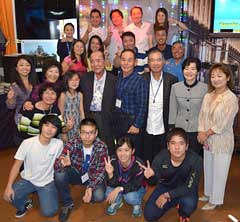
Gathering of Iijimanchu staying in Sao Paolo (photograph taken August 13 at a restaurant in Sao Paolo, Brazil)
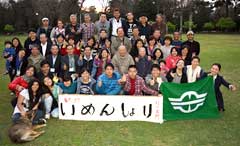
Gathering of Iijimanchu staying in Argentina (photograph taken August 17 at “Uruma Garden” in the suburbs of Buenos Aires)
(Translation by T&CT and Sandi Aritza)
Go to Japanese
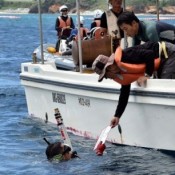
August 31, 2015 Ryukyu Shimpo
On the morning of August 31, the Okinawa Prefectural Government started a diving operation to investigate whether coral reef has been damaged in and around a temporary restricted area in Oura Bay, off the coast of Henoko, Nago. There, the Okinawa Defense Bureau is advancing preparations to build a new U.S. base to replace U.S. Marine Corps Air Station Futenma.
In February, the prefectural government requested that the U.S. military and the government of Japan allow it to carry out a survey because concrete blocks installed by the defense bureau for a seabed drilling survey have damaged coral reef outside of the planned reclamation area for the new base.
Fifteen officials of the prefectural government departed Teima Fishing Port at 9:30 a.m. on three ships. Four fishing boats employed by the Okinawa Defense Bureau left the same port at the same time. At 9:45 a.m., the prefectural government’s ships entered a temporary restricted area.
The prefectural government’s divers began to investigate the seabed along floats on the Sedake-side at 9:55 a.m. The defense bureau’s divers also jumped into the sea to monitor safety.
In August, the governments of Japan and the United States approved the prefectural government’s request to conduct the survey in the restricted area in Oura Bay during intensive consultations between the prefectural and the central governments over the Henoko issue.
The diving survey will take until at least September 12. The intensive consultations are scheduled to end on September 9.
(English translation by T&CT)
Go to Japanese

August 31, 2015 Ryukyu Shimpo
On the evening of August 30, at the Yogi Park in Naha, a rally demanding the scrapping of a new security bill, the cancellation of construction of a new U.S. base in Henoko, and the resignation of the Abe administration was held.
According to the organizer, about 2,500 people took part in the rally.
The rally was part of action that has taken place nationwide, including near the national parliament in Tokyo, demanding the scrapping of the security bill and the resignation of the Abe administration. To these slogans, the protestors in Okinawa added a slogan against the new U.S. base in Henoko, which is to replace U.S. Marine Corps Air Station Futenma in Ginowan.
The participants, including aged citizens who experienced the Battle of Okinawa, scholars, lawyers, diet and local assembly members, adopted the statement: “We will create a future where war will never happen.”
Tetsumi Takara, the president of the group that organized the event and a professor at the University of the Ryukyus, stated in his speech, “A bill that has strayed far from the Constitution and allows Japan to launch a war is being enacted in the Diet. Okinawan people will never allow this’war law’.”
After the gathering, the participants marched through Kokusai Street to the Okinawa Prefectural Government building, chanting to a rap by a member of the SEALDs RYUKYU, which is a youth group.
(English translation by T&CT)
Go to Japanese
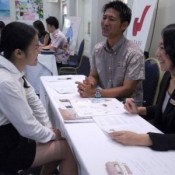
August 27, 2015 Ryukyu Shimpo
The Okinawa Prefectural Government and the Okinawa Convention and Visitors Bureau held a job fair at Hotel Royal Orion in Naha on the morning of August 27. The fair was aimed at 17 college and university students from China’s Fujian province who visited Okinawa to take a regional guide-interpreter examination for the fiscal 2015. Ten Okinawan companies including Okinawa Tourist Service, Okinawa Watabe Wedding, and the Sweet Bakery Porsche Co. took part in the fair and held interviews with the students. Fujian Normal University student Gen Yuen Han, who majored in Japanese language, said, “I used to interact with exchange students from Okinawa in China, which made me have a good impression of the prefecture. By taking advantage of my Japanese skills, I would like to land a job in an Okinawa travel company.”
(English translation by T&CT)
Go to Japanese
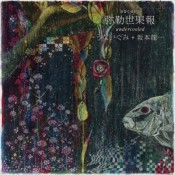
August 24, 2015 Ryukyu Shimpo
Folk singer Misako Koja has written lyrics for a song, “Undercooled,” which is originally composed by musician Ryuichi Sakamoto as part of a new album called, “Mirukuyugafu”, to be released on October 7. Koja’s group, Unaigumi, sings the song, which is a prayer to calmly, kindly, yet powerfully, make the dream of a peaceful Okinawa and Japan, and a war-free world come true through the power of music and songs. Kazuya Sahara, Koja’s husband and producer, worked with Koja on the lyrics. Sahara expressed gratitude to the composer; “I would like to thank Mr. Sakamoto who returned from a break following his treatment of oropharynx cancer, for thinking of Okinawa and working for the people of Okinawa.”
A part of the sales will be donated to the “Henoko Fund”, which aims to stop the relocation of the Futenma U.S. military base in Ginowan to Henoko.
“Undercooled”, meaning “not cooled down enough,” was written by Sakamoto in 2004. Concerning the 9.11 World Trade Center attack and Iraq War, the piece contains his message for the world; “the current world is as if it’s got all worked up. Let’s cool our head.”
(English translation by T&CT and Sayaka Sakuma)
Go to Japanese
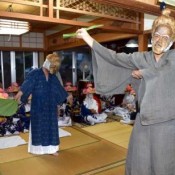
August 27, 2015 Ryukyu Shimpo
On August 26, the first day of Okinawa’s Obon, called Unke in Ishigaki City, a traditional Yaeyama ceremony, Angama, was held throughout the community. Messengers from Guso (afterlife), Ushumai (an old man) and Nmii (an old woman) brought Fama (descendants) wearing Hanagasa (a flower hat) and visited households. They offered songs and dance to ancestors and entertained the audience by answering questions. Angama is a celebration of the return of ancestral spirits and a chance to pray for prosperity.
Angama visited Eiko Kawaidaira’s house in Tonoshiro around 7 p.m. While Fama performed dance, Ushumai and Nmii had conversations with the audience in high-pitched voices.
To the question, “Why does Okinawa’s Obon take three days?”, they answered in Yaeyama language, “Obon is like the New Year’s three-day holiday in Guso.” “If you want to know more, let’s go to Guso together.” The audience laughed. Eleven-year-old granddaughter of Kawahira, Kanon Ohama said, “It was funny to see them get lost for words trying to answer difficult questions.”
(English translation by T&CT and Megumi Chibana)
Go to Japanese
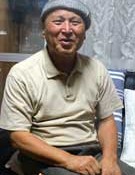
August 27, 2015 Ryukyu Shimpo
Hiroji Yamashiro, a leading figure in the opposition movement continuing in front of Camp Schwab, Henoko, against construction of the new base, and chairman of the Okinawa Peace Movement Center, was released from hospital on the 26th of this month. He has been hospitalized since the end of April fighting malignant lymphoma. He still requires medical observation, but he voiced his desire to return to the front of the Camp Schwab gate, and convey the message nationwide that the opposition movement’s vitality will ensure they do not lose the fight for Henoko.
Yamashiro’s wife, Takiko, and son, Hiroya, escorted him when he was released from the hospital. Nurses applauded Yamashiro upon his departure. While they acknowledged that he would still need blood tests and other procedures, they expressed joy and relief that his hospitalization was over.
At the start of September, Yamashiro plans to greet the people continuing the movement in front of the Camp Schwab gate. He said, “My goal is to participate in the sit-in action in October. I want to declare the message nationwide that we cannot accept this road to war.”
Upon hearing the news of Yamashiro’s release from the hospital, Hiroshi Ashitomi, a co-representative of the Helicopter Base Objection Association, welcomed Yamashiro’s return, encouraging him to recover physically and come back to the sit-in.
(English translation by T&CT and Erin Jones)
Go to Japanese
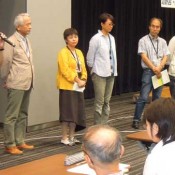
August 27, 2015 Ryukyu Shimpo
On August 26, fourteen NGOs and citizens’ groups established the “Protect Henoko and Takae! NGO Network.” Among the groups participating in the network were FoE Japan, Greenpeace Japan, Ramsar Network Japan, Peace Boat, and other groups and organizations involved in environmental issues, peace, and international cooperation in Japan and abroad. An event was held in Tokyo to mark the network’s establishment. Its goal is to oppose the new base construction in Henoko/Oura Bay and Takae, to protect biological diversity, and to promote sustainable development.
The network plans to work in cooperation with local residents and Okinawan organizations in order to oppose the construction of a new base in Henoko, Nago City and the construction of new helipads in Takae, Higashi Village. These projects are being carried out as part of a plan to return the land where U.S. Marine Corps Air Station Futenma sits, and part of the U.S. military’s Northern Training Area, to Japanese administration. Around 160 members of various citizens’ groups attended the event to mark the network’s founding. Representatives of the network spoke of their desire to tell the world about the magnificence of Henoko and Okinawa’s northern Yambaru region, and their hope to increase public interest throughout Japan in these issues.
Okinawa University professor emeritus Kunitoshi Sakurai, a member of the experts’ panel that investigated the former Okinawan governor’s authorization of the Henoko land reclamation, gave a commemorative speech at the event. In his speech, he explained problems with the former governor’s authorization, which the panel deemed to be legally flawed.
(Translation by T&CT and Sandi Aritza)
Go to Japanese
August 21, 2015 Ryukyu Shimpo
The number of tourists visiting Okinawa in July increased 9.2 percent from the same month in 2014 to a record 714,000 visitors, according to data released by the Department of Culture, Tourism and Sports on August 20. It was the first time the number of tourist visits in July has exceeded 700,000.
The monthly number of tourists visiting Okinawa has reached new records for 34 months in a row. The number of foreign tourists visiting in July increased 76.6 percent from the same month in 2014 to 163,000. The number of Chinese tourists in that month increased 2.7 times from the same month last year to 40,700, which accounted for 25 percent of foreign tourists.
Meanwhile, the number of July domestic tourists decreased 1.9 percent to 551,000 for two months in a row. The number of domestic tourists in June decreased 0.2 percent from the same month 2014.
An official from the prefectural government said, “The number of domestic tourists decreased due to typhoons. Meanwhile, the number of foreign tourists increased due to the introduction of new international flights and an increase in cruise port calls to eight times that of same month last year.”
The number of tourists from Taiwan increased 32.1 percent to 51,800, Hong Kong up 79.7 percent to 23,000, and Korea up 2.1 times to 21,300.
The number of domestic tourists from the Tokyo area decreased 1.8 percent to 287,400, the Kansai area down 1.0 percent to 112,000, the Nagoya area down 4.9 percent to 42,700 and the Fukuoka area up 3.3 percent to 63,500.
(English translation by T&CT and Hitomi Shinzato)
Go to Japanese

August 26, 2015 Ryukyu Shimpo
According to a quick estimation announced by the Okinawa Prefectural Government on August 25, the amount of damage to agriculture, forestry and fisheries caused by Typhoon Goni reached a total of 781,640,000 yen.
Yaeyama islands, where the typhoon registered a maximum instantaneous wind speed of 71.0 meters per second on Ishigaki, had the largest damage amount at 596,920,000 yen.
The cost of damages in Kumejima and Taketomijima islands is being assessed. The estimated total amount of damages wil increase.
Looking at the damage cost on a regional basis, the Yaeyama region accounted for about 76.3 percent of the total amount of damage. In the area, six floating piers and 77 livestock barns were reportedly destroyed by the storm rain.
The Miyako region had a damage cost of 164,410,000 yen, the second largest amount after the Yaeyama region. Sugarcane accounted for most of the crops damaged in the Miyako region.
There was serious damage to agriculture, including to most of the main crops such as sugarcane and vegetables, costing 490,440,000 yen.
The fishing industry reported damage of 234,200,000 yen.
This year, four typhoons have hit Okinawa.
As of August 12, the amount of damage to agriculture, forestry and fisheries caused by the typhoons reached about 3,937,770,000 yen, the third largest damage cost in the past 10 years.
(English translation by T&CT)
Go to Japanese
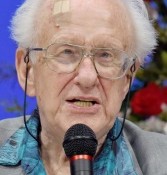
August 23, 2015 Ryukyu Shimpo
On August 22, Johan Galtung, world-renowned as ‘the father of peace studies’, came to Okinawa to speak at a symposium at Urasoe’s Tedako Hall, hosted by the Ryukyu Shimpo and New Diplomacy Initiative, titled, “70 Years After World War II, Galtung Speaks on Proactive Peace and Okinawa.” Prior to the symposium, Galtung visited Henoko, Nago, where the construction of a new military base is in progress. There, he criticized the Japanese government’s stance, saying, “Prime Minister Abe has misappropriated the term ‘proactive peace.’ What he’s trying to do is exactly the opposite of what I intended the concept to mean.” During his presentation at the symposium, he called the exercise of collective self-defense currently under deliberation in the national Diet an “anachronistic form of national security,” and declared that it goes against the mood of the times. He further argued that Okinawa should proactively advance the idea of an umbrella of peace encompassing all of Northeast Asia.
Galtung pronounced that the world is heading toward a new “order of peace” in which military bases will gradually disappear. He predicts that by 2020, Northeast Asia will move toward the development of a regional community following in the footsteps of the European Union and the Association of South East Asian Nations.
He stated that within Northeast Asia, a region comprising Japan, Russia, South Korea, North Korea, China, and Taiwan, Okinawa’s location is geopolitically very significant. He pointed out that aside from Taiwan, Japan has a less than positive relationship with all of its other neighbors due to territorial disputes surrounding the Senkaku Islands, Takeshima, and the Northern Territories. However, he emphasized that rather than a “nuclear umbrella,” what needs to be built is an “umbrella of peace.” He proposed that Okinawa develop a spirit of independence, perhaps acquiring special prefecture status, invite international institutions, and quickly announce its candidacy as the headquarters of a new regional community.
Galtung further expressed his understanding that Okinawa has been continuously treated as a colony of the United States and Japan. He said that in order to overcome that, Okinawa must work proactively for peace in Northeast Asia, rather than simply declaring opposition to the bases in Okinawa. He suggested inviting NGOs from neighboring countries to Okinawa to engage in discussions about how to solve the problems faced in Okinawa and in the region.
A panel discussion followed Galtung’s presentation, with panelists including Okinawa International University professor emeritus Masaie Ishihara, Okinawa Women Act Against Military Violence co-representative Suzuyo Takazato, and University of the Ryukyus professor Masaaki Gabe. An audience of around 700 listened attentively.
(Translation by T&CT and Sandi Aritza)
Go to Japanese












 Webcam(Kokusai Street)
Webcam(Kokusai Street)


